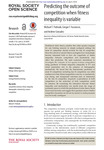Predicting the outcome of competitionwhen fitness inequality is variable
| dc.contributor.author | Pedruski, Michael T. | en_US |
| dc.contributor.author | Fussmann, Gregor F. | en_US |
| dc.contributor.author | Gonzalez, Andrew | en_US |
| dc.date.accessioned | 2016-10-11T05:37:50Z | |
| dc.date.available | 2016-10-11T05:37:50Z | |
| dc.date.issued | 2015 | en_US |
| dc.identifier.other | HPU4160592 | en_US |
| dc.identifier.uri | https://lib.hpu.edu.vn/handle/123456789/23674 | en_US |
| dc.description.abstract | Traditional niche theory predicts that when species compete for one limiting resource in simple ecological settings the more fit competitor should exclude the less fit competitor. Since the advent of neutral theory ecologists have increasingly become interested both in how the magnitude of fitness inequality between competitors and stochasticity may affect this prediction. We used numerical simulations to investigate the outcome of two-species resource competition along gradients of fitness inequality (inequality in R∗)and initial population size in the presence of demographic stochasticity. | en_US |
| dc.format.extent | 10 p. | en_US |
| dc.format.mimetype | application/pdf | en_US |
| dc.language.iso | en | en_US |
| dc.subject | Biology | en_US |
| dc.subject | Ecology | en_US |
| dc.subject | Theoretical biology | en_US |
| dc.subject | Competitive exclusion | en_US |
| dc.subject | Fitness inequality | en_US |
| dc.subject | Demographic stochasticity | en_US |
| dc.subject | Resource competition | en_US |
| dc.title | Predicting the outcome of competitionwhen fitness inequality is variable | en_US |
| dc.type | Article | en_US |
| dc.size | 500KB | en_US |
| dc.department | Education | en_US |
Files in this item
This item appears in the following Collection(s)
-
Education [806]

